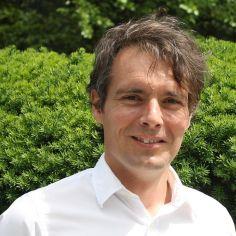Event
Physical Chemistry Seminar: Dr. Lars Gundlach, University of Delaware
"Dynamics of Charge and Energy Transfer in Hybrid Materials"

Abstract
-Coupling between different forms of excitation in matter is an important topic that is relevant for fundamental science as well as applications such as solar energy conversion, sensing and electro-optical devices. The strength of this coupling is often challenging to predict from theory and in many cases leads to ultrafast dynamics on the femtosecond scale. Real-time measurements are a reliable tool to measure the dynamics of conversion between excitations.
I will present two model systems that were developed to investigate electronic-vibrational coupling and coupling between localized surface plasmons and excited charge carriers. First, on a hybrid molecule/semiconductor charge transfer system and, second, on plasmonic hybrid metal/semiconductor nanostructures.
(1) Ultrafast charge transfer dynamics at interfaces is a critical process in surface catalysis, novel electronic applications and solar energy conversion. It is well known that electron transfer between a surface bound molecule and a semiconductor can be accompanied by vibrational excitation of the cation due to the Frank-Condon overlap of the excited state and the cation. The Influence of the substitution position of single or dual linker groups on interfacial electron transfer dynamics will be presented. This study shows that small conformational changes and vibrational coupling can have a significant influence on electron transfer even on the femtosecond time scale.
(2) Due to their unique optical properties plasmonic metal/semiconductor nano-heterostructures (MSNH) are promising materials for applications ranging from imaging and photonics to solar energy conversion and photocatalysis. In recent years, several charge transfer and resonant energy transfer mechanisms have been proposed for plasmons in MSNHs, however, the very first steps of plasmon decay and coupling have not been directly observed yet due to their short lifetime of only tens of femtoseconds. The new approach that is presented here combines model systems consisting of ordered nanoparticle arrays with exceptional homogeneity that enable systematic variations in materials properties and that are compatible with ultrafast chirp-free transient absorption measurements with time resolution below 20 fs
Research Projects
Energy transport on the nanoscale probed via ultrafast laser spectroscopy
Electron transfer reactions at interfaces
Charge carrier dynamics in nanomaterials
https://www1.udel.edu/chem/gundlach/projects.html
Host: Dr. ANNA
